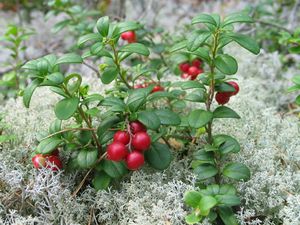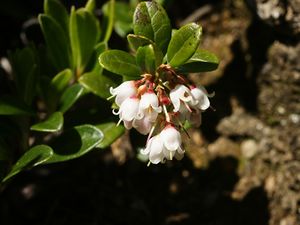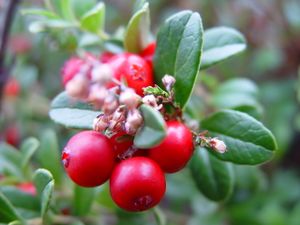عنب الجبل الأحمر
| Lingonberry | |
|---|---|

| |
| Vaccinium vitis-idaea var. vitis-idaea in reindeer lichen | |
| التصنيف العلمي | |
| مملكة: | |
| (unranked): | |
| (unranked): | |
| (unranked): | |
| Order: | |
| Family: | |
| Genus: | |
| Species: | V. vitis-idaea
|
| Binomial name | |
| Vaccinium vitis-idaea L. 1753
| |
| Synonyms[1] | |
|
Synonymy
| |
عنب الجبل الأحمر Vaccinium vitis-idaea هو الشجيرة الصغيرة التي يبلغ طولها من 10-40 سم ، تنمو على الجبال المنخفضة والمتوسطة ، ويوجد في غابات جبال الألب و جبال الأبنين الشمالية. وحباته حمراء تنضج في شهري أغسطس وسبتمبر.
. . . . . . . . . . . . . . . . . . . . . . . . . . . . . . . . . . . . . . . . . . . . . . . . . . . . . . . . . . . . . . . . . . . . . . . . . . . . . . . . . . . . . . . . . . . . . . . . . . . . . . . . . . . . . . . . . . . . . . . . . . . . . . . . . . . . . . . . . . . . . . . . . . . . . . . . . . . . . . . . . . . . . . . .
الأسماء
|
|
الوصف
Vaccinium vitis-idaea spreads by underground stems to form dense clonal colonies. Slender and brittle roots grow from the underground stems. The stems are rounded in cross-section and grow from 10 to 40 cm (4 to 16 in) in height. Leaves grow alternately and are oval, 5–30 mm (0.2–1.2 in) long, with a slightly wavy margin, and sometimes with a notched tip.
The flowers are bell-shaped, white to pale pink, 3–8 mm (0.1–0.3 in) long, and produced in the early summer.
التنويعات
الزريعات
الخصائص الغذائية
The berries contain plentiful organic acids, vitamin C, vitamin A (as beta carotene), B vitamins (B1, B2, B3), and the elements potassium, calcium, magnesium, and phosphorus.[3] In addition to these nutrients, they also contain phytochemicals that are thought to counteract urinary-tract infections, and the seeds are rich in omega-3 fatty acids.[بحاجة لمصدر]
الطب التقليدي
In folk medicine, V. vitis-idaea has been used as an apéritif, astringent, antihemorrhagic, anti-debilitive, depurative, antiseptic (especially for the urethra), a diuretic, a tonic for the nervous system, and in various ways to treat breast cancer, diabetes mellitus, rheumatism, and various urogenital conditions.[4] In traditional Austrian medicine the fruits have been administrated internally as jelly or syrup for treatment of disorders of the gastrointestinal tract, kidneys and urinary tract, and fever.[5]
Related species
Vaccinium vitis-idaea differs from the similar cranberries in having white flowers with petals partially enclosing the stamens and stigma, rather than pink flowers with petals reflexed backwards, and rounder, less pear-shaped berries.
Hybrids between Vaccinium vitis-idaea and Vaccinium myrtillus, named Vaccinium × intermedium Ruthe, are occasionally found in Europe.[6]
References
- ^ The Plant List, Vaccinium vitis-idaea L.
- ^ Hall, Joan Houston (2002). Dictionary of American Regional English. Harvard University Press. p. 47. ISBN 0-674-00884-7. Retrieved 2007-11-16.
- ^ "Lingonberry, raw - Nutrition Information and Facts". Department of Nutrition, National Food Institute - Technical University of Denmark. 2009-01-13. Retrieved 2015-09-17.
- ^ James A. Duke. "Vaccinium vitis-idaea (ERICACEAE)". Dr. Duke's Phytochemical and Ethnobotanical Databases. Retrieved May 22, 2011.
- ^ Vogl, S; Picker, P; Mihaly-Bison, J; Fakhrudin, N; Atanasov, AG; Heiss, EH; Wawrosch, C; Reznicek, G; Dirsch, VM; Saukel, J; Kopp, B (2013). "Ethnopharmacological in vitro studieson Austria's folk medicine - An unexplored lore in vitro anti-inflammatory activities of 71 Austrian traditional herbal drugs". J Ethnopharmacol. 149: 750–71. doi:10.1016/j.jep.2013.06.007. PMC 3791396. PMID 23770053.
- ^ خطأ استشهاد: وسم
<ref>غير صحيح؛ لا نص تم توفيره للمراجع المسماةFlora




